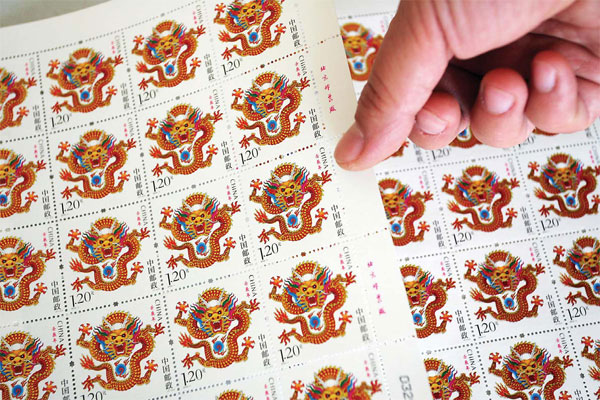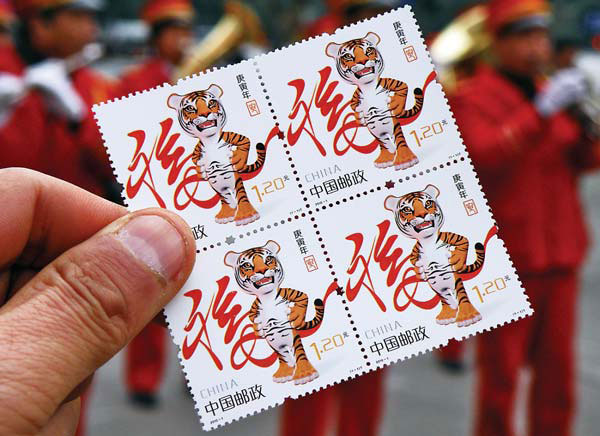Chasing the Dragon...and the Monkey and the Rooster
Updated: 2012-01-29 08:18
By Han Bingbin (China Daily)
|
||||||||
The Chinese zodiac's 12 animal signs are always popular symbols in both East and West. And when the Lunar New Year arrives, enthusiasts all over the world are eager to get their hands on the best collections. This year, the focus is on stamps. Han Bingbin reports.
As a zodiac mascot, the dragon soars above its peers as the symbol of the year. Compared to the rabbit (which just gave up its one-year reign), the ox, rat, snake, monkey, pig, goat, rooster, tiger, horse and dog, the dragon is a notch above. Why? Because it is the only mystical beast in the zodiac barnyard and it also bears the aura of aristocracy. Its fire-breathing looks sometimes give rise to a misunderstanding. For example, the official dragon stamp released to commemorate the Spring Festival this year was criticized for its ferocious demeanor. Chinese netizens were quick to criticize the image on the stamp as "overbearing" and asked if it should not have been more benign.
|
 |
|
Designer Chen Shaohua say his dragon stamp this year was inspired by the motifs on the imperial Qing robes and Nine Dragon Wall in the Forbidden City. Zhang Chi / for China Daily |
The stamp's creator, designer Chen Shaohua defended his design online in his blog, carefully avoiding confrontation by refusing media interviews. The dragon's role in mythology was to ward off evil, he says. As a deified image passed down through generations, it deserves the respect and dignity of preserving its legendary reputation, and should not be subjected to arbitrary changes.
|
 |
|
Chen Shaohua, designer of the 2012 dragon zodiac stamp, defends his design. Shang Hongtao / for China Daily |
Chen is no greenhorn. He had previously designed four zodiac stamps over the last 20 years.
The selection committee this year had requested a younger, more modern dragon, he said on his blog, but Chen justified his design saying his dragon image was inspired by the patterns on the imperial Qing robes and Nine Dragon Wall. He said it symbolized China's growing confidence and importance on the world stage.
Chen probably learned from past experience. In 2010, his stamp design for the Year of the Tiger featured an affable-looking mother tiger sitting with her cub. The design lost to a rival entry that showed a youthful and energetic tiger, standing hands on hips.
|
 |
|
The Year of the Tiger in 2010 featured an updated tiger with hands on hips, while the more traditional dragon ruled on a postage stamp issued in France. |
However, collectors are unfazed by the chatter online. The negative comments have had no effect on sales. All over China, people lined up in the chill of winter to snap up the dragon stamps. When the stamps sold out at the post offices and official sources, the private market starting getting active and price hikes sent the value of the stamps soaring like, well, dragons.
By early January, a set of 20 dragon stamps was selling for as much as 350 yuan ($55) at Beijing's Madian Memorabilia Market, the biggest stamp market in Asia, compared with the original price of 24 yuan from the post office. Experts say many collectors are already prepared to pay more.

 Relief reaches isolated village
Relief reaches isolated village
 Rainfall poses new threats to quake-hit region
Rainfall poses new threats to quake-hit region
 Funerals begin for Boston bombing victims
Funerals begin for Boston bombing victims
 Quake takeaway from China's Air Force
Quake takeaway from China's Air Force
 Obama celebrates young inventors at science fair
Obama celebrates young inventors at science fair
 Earth Day marked around the world
Earth Day marked around the world
 Volunteer team helping students find sense of normalcy
Volunteer team helping students find sense of normalcy
 Ethnic groups quick to join rescue efforts
Ethnic groups quick to join rescue efforts
Most Viewed
Editor's Picks

|

|

|

|

|

|
Today's Top News
Health new priority for quake zone
Xi meets US top military officer
Japan's boats driven out of Diaoyu
China mulls online shopping legislation
Bird flu death toll rises to 22
Putin appoints new ambassador to China
Japanese ships blocked from Diaoyu Islands
Inspired by Guan, more Chinese pick up golf
US Weekly

|

|






